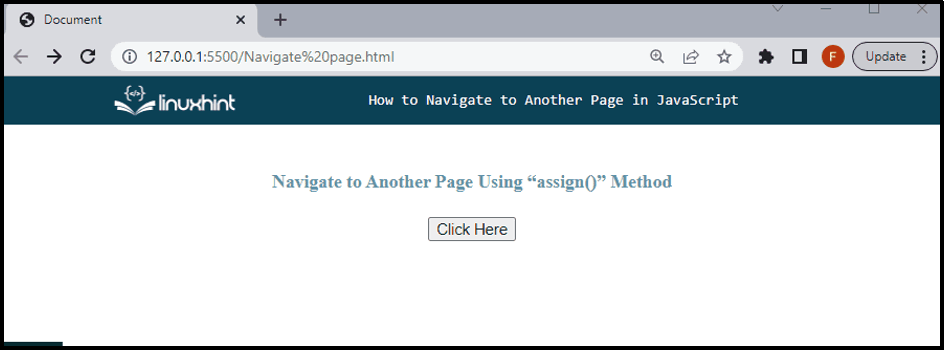This tutorial will demonstrate the methods to navigate the page to another page using JavaScript.
How to Navigate to Another Page in JavaScript?
For navigating or redirecting, use the following JavaScript approaches:
Method 1: Navigate to Another Page Using “location.assign()” Method
Use the “assign()” method with the “location” object for navigating a page to another page. It redirects the browser to the provided URL in the same way as a hyperlink would.
Syntax
The following syntax is utilized for the assign() method to redirect the page to another page:
It takes a “URL” path as an argument where the page will redirect:
Example
In an HTML file, create a button that will redirect to the official website of the Linuxhint on the button click:
Define a function “navigatePage()” in a JavaScript file, that will trigger on the button click. This function calls the “assign()” method by passing the URL as an argument for redirecting to the official linuxhint.com website:
location.assign("https://linuxhint.com");
}
As you can see that we have been successfully navigated to the linuxhint.com website on the button click:
At the top left corner, you can see that after navigating to the linuxhint.com website, the back arrow button is enabled. This means that it allows you to go back or navigate to the previous page.
Method 2: Navigate to Another Page Using “location.replace()” Method
To navigate to another page, use the JavaScript built-in “location.replace()” method. It is used to replace the current document/page with a new page. This method is similar to location.assign(), but the difference is it replaces the page and not allows you to navigate back.
Syntax
Follow the provided syntax for the replace() method:
Example
Call the replace() method with the specified URL in the defined function:
location.replace("https://linuxhint.com");
}
The output indicates that the page has been successfully navigated but you can see that it does not allow going back to the previous page as the back button is disabled:
Method 3: Navigate to Another Page Using “location.href” Attribute
You can also use the “href” property with the “location” object for navigating to another page using JavaScript. For navigation, assign a new value of URL to it. The “href” attribute indicates the current page URL. By giving it a new value, it can be used to go to the other URL.
Syntax
The given syntax is utilized for the href attribute to navigate the page to another page:
Example
Assign the URL to the href attribute in the defined function for redirecting to the linuxhint.com official page:
location.href = "https://linuxhint.com";
}
Output
That’s all about navigating or redirecting to another page in JavaScript.
Conclusion
To navigate the page to another page, use the “location.assign()” method, “location.replace()” method, or the “location.href” attribute. The “assign()” method and the “href” attribute allow back navigation while the “replace()” method does not allow navigating back to the previous page. This tutorial demonstrated the methods for navigating the page to another page using JavaScript.



